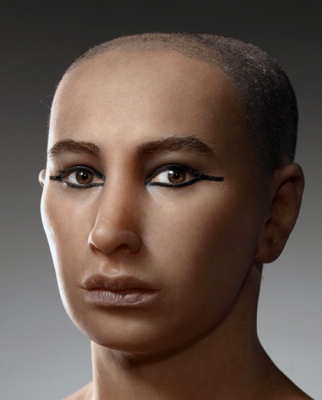
Vanity is as old as civilization, and the ancient Egyptians were no exception. Both men and women were known to wear copious amounts of makeup, which they believed gave them the protection of the gods Horus and Ra. These cosmetics were made by grinding ores like malachite and galena into a substance called kohl. It was then liberally applied around the eyes with utensils made out of wood, bone and ivory. Women would also stain their cheeks with red paint and use henna to color their hands and fingernails, and both sexes wore perfumes made from oil, myrrh and cinnamon. The Egyptians believed their makeup had magical healing powers, and they weren’t entirely wrong: Research has shown that the lead-based cosmetics worn along the Nile actually helped stave off eye infections.
The interior passageways of the Valley of the Kings and Queens are embellished with frescoes illustrating daily life in ancient Egypt as well as the afterlife. They showed strapping men sporting dark eye makeup created from ground mineral powders and fats. The smoky kohl liner they wore served both practical and ritualistic purposes. It was thought to repel flies, protect the eyes from the sun’s rays and ward off infection. The dramatic makeup also imitated the facial markings of the sun god Horus, who was often depicted as a falcon.
Ancient Egyptians paid careful attention to facial and body hair, as evidenced by hair stylists and barbers depicted in their artwork. For men, only during times of mourning were they allowed to abandon shaving or trimming their beards. Male priests plucked out all their body hair, including eyebrows and lashes, to sanctify themselves. Upper-class Egyptians would regularly wear perfumed wigs and false beards of human hair, and even lower-class citizens would don faux extensions made of vegetable fiber.
In addition to their function as skin moisturizers, oils and animal fats were also utilized for hair care. Men might rub the fat from a lion, snake, or other animal onto their scalps as a homeopathic remedy for baldness. Egyptians also delayed going gray by covering silvery strands with red-tinted henna dye. On festive occasions, men and women secured scented cones of dried fats on the tops of their heads. Melting in the heat, the cones then released the fragrance of pressed lilies, myrrh, cardamom and other flowers and spices.
Socially, cosmetics and accessories reflected one’s rank in ancient Egypt, as in today’s culture to some extent. Like designer handbags toted around as a status symbol, one sign of a wealthy Egyptian woman was a portable cosmetics box. On the other end of the social spectrum, female dancers and concubines were tattooed with dotted designs and images of Bes, the goddess of song and home.
After death, beauty aids still weren’t far from reach. Within the Valley of the Kings and Queens, those laborers of Deir el-Medina transported cosmetic items such as boxes of wigs, glittering jewelry and palettes of eye shadow into the burial chambers. Higher-ranking craftsmen in the village may also have been interred with similar comforts. Even in the afterlife, ancient Egyptian men and women needed to primp.
Credit : How stuff works
Picture Credit : Google




